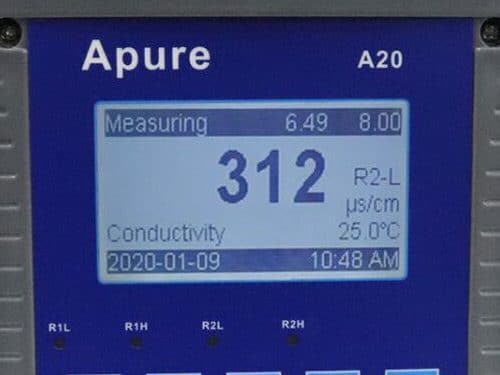The SI unit of measurement for conductivity is called Siemens(S). Typically, conductivity measurements are displayed in milliSiemens per centimeter (mS/cm) or microSiemens per centimeter (μS/cm). It is important to understand how to convert measurements from mS/cm to uS/cm (and vice versa) to ensure that you get an accurate conductivity measurement and then draw appropriate conclusions about the ion concentration of your sample.

About Conductivity
Looking at just a glass of tap water and a glass of salt water, it is difficult to imagine that the liquid in each has the potential to conduct electricity, and that one of the samples will do so more effectively than the other. Why is this and why is it important to measure it?
Electrical conductivity (also known as electrical conductivity or EC) is a measure of a solution’s (you guessed it) ability to conduct electricity. The conductivity of a sample indicates the total concentration of ions present in it.
Units of conductivity
The SI unit of measurement for conductivity is called Siemens(S). Conductivity measurements are most commonly measured in millisiemens per centimeter (mS/cm) or microSiemens per centimeter (μS/cm). See below for mS/cm to uS/cm conversions, or plug in the MilliSiemens values you wish to convert to MicroSiemens in the calculator below.
How to convert mS/cm to µS/cm
1 millisecond = 1000 microseconds;
1 µS = 0.001 milliseconds
MilliSiemens to MicroSiemens calculator
Millisiemens to MicroSiemens conversion
Type a value in the Millisiemens field to convert the value to Microsiemens.
Millisiemens mS.
U.S. MicroSiemens.
Application
Because measured conductivity is a good indicator of the presence of conductive ions in a solution, conductivity is a common measurement in a wide range of industries, such as
Water Treatment
By measuring the magnitude of conductivity, the concentration of electrolytes contained in a solution can be indirectly calculated to understand the content of electrolytes in water, and the magnitude of conductivity can be used to initially determine the condition of water quality, which in turn can be used to adopt different water treatment solutions.
Agriculture
Conductivity can infer the amount of salts, dissolved nutrients and dissolved solids in the soil and is a good way to determine if more water or fertilizer is needed.
Aquariums and aquaculture
An easy way to check the salinity and total dissolved solids of any water is to use a conductivity meter. You can convert to total dissolved solids (TDS) or salinity manually, or you can use a pH and conductivity meter with this conversion feature built in.
Boiler Maintenance
Boiler systems have a lot of feed water. This water contains impurities that can eventually cause problems. Any buildup of impurities can affect the efficiency of the boiler. A conductivity meter allows you to monitor the water for impurities and indicates when boiler drainage should occur.
The use of conductivity meters is essential in many applications and industries. These devices allow you to directly determine the total ion concentration in a sample. Using the information we have provided above, you can easily convert mS/cm to uS/cm for your measurement needs and ensure that you do not misinterpret any results.
Read more about conductivity:
What is EC?
What is ec meter?
What is dissolved oxygen?
Main water quality indicators
